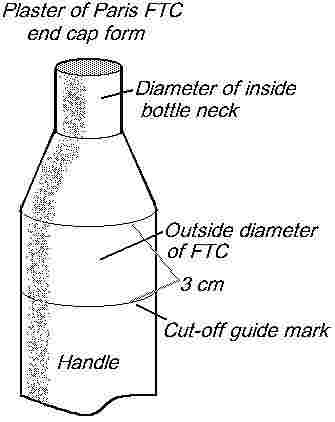Bottle Neck Caps For Fluorescent Tube Covers
A technique for making ends for water rockets using
fluorescent tube covers and 500 ml Dr Pepper bottles.
Fluorescent tube covers are long plastic
(polycarbonate)
tubes sold in hardware and lighting stores. They are designed to
slip over Fluorescent light bulbs to prevent a broken bulb from
showering
anyone below it with broken glass. Readily available in the USA,
they might be difficult to find in countries with fewer or different
safety
regulations. Needless to say, being extremely tough, about 42 mm
(1 3/8 in) in diameter and coming in lengths over 2 meters (8 ft), it
was
only a matter of time before a water rocketeer noticed this material.
There are reportedly some good fits to FTC using
commercial model rocket nosecones. This will work fine if you
don't
need to put anything on top of your rocket, but it will get expensive
unless
you are using water recovery.* The following describes a method I
use based on the conical shape of 500 ml Dr Pepper bottle neck.
*It is possible to trim one of these rockets so that
it descends horizontally
at a non-dangerous speed, but I suspect this will ultimately cost you
altitude.
Make a mold for plaster of paris by drilling a
carefully
centered 1 3/8 inch hole in the bottom of a Dr Pepper bottle
using
a spur drill (A spade drill bit with spikes at the corners of the
cutting
edge.) Smear Vaseline inside the bottle neck as a release
agent,
cap the bottle and insert a square cut piece of FTC that is long enough
to stick out the bottom of the bottle. Pour plaster into the FTC
and let it harden. If you are smarter than I am you might think
about
how you are going to hold this assembly while the plaster sets before
you mix the plaster. When it is hard, you can twist and pull the
form out of the bottle, but leave the FTC on the plaster. Clean
off
any plaster that might have leaked out around the FTC inside the
bottle.
I made a line 3 cm from the shoulder on the FTC to guide my scissors
when
I trim bottlenecks before shrinking them.
 Cut
off the neck of a Dr. Pepper bottle at the shoulder, slip it onto the
plaster
form, trim it to the line, and shrink it with a heat gun. You
will
find this makes a snug fit with FTC in a minute or so.
Cut
off the neck of a Dr. Pepper bottle at the shoulder, slip it onto the
plaster
form, trim it to the line, and shrink it with a heat gun. You
will
find this makes a snug fit with FTC in a minute or so.
The contact surfaces inside the neck and outside
the FTC are roughened with coarse sand paper, and I glue them together
with Household Goop because it is hard to find the superior but uglier
PL Premium where I live. Using Goop, it is easy to level the glue
squeezed out with a moistened finger. Use rubber gloves if you
handle
PL Premium at all.
Using this technique, it is easy to put two nozzles
on an FTC. Thinking about it another way, it is also easy to put
on a nozzle and a threaded fitting. I glue (Goop again) two
bottle
caps together, back to back, and put a Pop rivet through them.
Use
a washer to get the rivet tight. This makes an air-tight
female-female
adapter. Then anything I can make based on the male threaded neck
of a bottle, for example, payload chambers or recovery systems,
securely
screws onto the front of my rocket. I make a fairing from another
bottle or short piece of FTC to cover the linkage. These rockets
are modular, and it is
easy to switch and swap parts.
7/25/00 Gordon B. McDonough